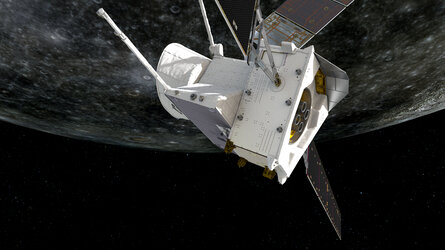Accept all cookies Accept only essential cookies See our Cookie Notice

About ESA
The European Space Agency (ESA) is Europe’s gateway to space. Its mission is to shape the development of Europe’s space capability and ensure that investment in space continues to deliver benefits to the citizens of Europe and the world.
Highlights
ESA - United space in Europe
This is ESA ESA facts Member States & Cooperating States Funding Director General Top management For Member State Delegations European vision European Space Policy ESA & EU Space Councils Responsibility & Sustainability Annual Report Calendar of meetings Corporate newsEstablishments & sites
ESA Headquarters ESA ESTEC ESA ESOC ESA ESRIN ESA EAC ESA ESAC Europe's Spaceport ESA ESEC ESA ECSAT Brussels Office Washington OfficeWorking with ESA
Business with ESA ESA Commercialisation Gateway Law at ESA Careers Cyber resilience at ESA IT at ESA Newsroom Partnerships Merchandising Licence Education Open Space Innovation Platform Integrity and Reporting Administrative Tribunal Health and SafetyMore about ESA
History ESA Historical Archives Exhibitions Publications Art & Culture ESA Merchandise Kids Diversity ESA Brand Centre ESA ChampionsLatest
Space in Member States
Find out more about space activities in our 23 Member States, and understand how ESA works together with their national agencies, institutions and organisations.
Science & Exploration
Exploring our Solar System and unlocking the secrets of the Universe
Go to topicAstronauts
Missions
Juice Euclid Webb Solar Orbiter BepiColombo Gaia ExoMars Cheops Exoplanet missions More missionsActivities
International Space Station Orion service module Gateway Concordia Caves & Pangaea BenefitsLatest
Space Safety
Protecting life and infrastructure on Earth and in orbit
Go to topicAsteroids
Asteroids and Planetary Defence Asteroid danger explained Flyeye telescope: asteroid detection Hera mission: asteroid deflection Near-Earth Object Coordination CentreSpace junk
About space debris Space debris by the numbers Space Environment Report In space refuelling, refurbishing and removingSafety from space
Clean Space ecodesign Zero Debris Technologies Space for Earth Supporting Sustainable DevelopmentLatest
Applications
Using space to benefit citizens and meet future challenges on Earth
Go to topicObserving the Earth
Observing the Earth Future EO Copernicus Meteorology Space for our climate Satellite missionsCommercialisation
ESA Commercialisation Gateway Open Space Innovation Platform Business Incubation ESA Space SolutionsLatest
Enabling & Support
Making space accessible and developing the technologies for the future
Go to topicBuilding missions
Space Engineering and Technology Test centre Laboratories Concurrent Design Facility Preparing for the future Shaping the Future Discovery and Preparation Advanced Concepts TeamSpace transportation
Space Transportation Ariane Vega Space Rider Future space transportation Boost! Europe's Spaceport Launches from Europe's Spaceport from 2012Latest

BepiColombo's fifth Mercury flyby
Thank you for liking
You have already liked this page, you can only like it once!
On Sunday 1 December 2024, BepiColombo will fly past planet Mercury for the fifth time, readying itself for entering orbit around the Solar System’s mysterious innermost planet in 2026.
The spacecraft will fly between Mercury and the Sun, getting to within 37 630 km from the small planet’s surface at 15:23 CET. This is much farther than its first four flybys of the planet, when BepiColombo flew as close as 165–240 km from the surface.
What makes this flyby special is that it will be the first time that BepiColombo’s MERTIS instrument is able to observe Mercury. This radiometer and thermal infrared spectrometer will measure how much the planet radiates in infrared light, something which depends on both the temperature and composition of the surface.
This will be the first time that any spacecraft measures what Mercury looks like in mid-infrared wavelengths of light (7–14 micrometres). The data that MERTIS will collect throughout the mission will reveal what types of minerals the planet’s surface is made of, one of the key Mercury mysteries that BepiColombo is designed to tackle.
BepiColombo’s other science instruments will monitor the environment outside Mercury's magnetic field. Among other things, they will measure the continuous (but changeable) stream of particles coming from the Sun known as the solar wind.
The other instruments switched on during this flyby are the magnetometers MPO-MAG and MMO-MGF, the MGNS gamma-ray and neutron spectrometer, the SIXS X-ray and particle spectrometer, the MDM dust monitor and the PWI instrument which detects electric fields, plasma waves and radio waves.
BepiColombo, a joint mission between ESA and the Japan Aerospace Exploration Agency (JAXA), will be the second and most complex mission ever to orbit Mercury. It comprises two science orbiters: ESA’s Mercury Planetary Orbiter and JAXA’s Mercury Magnetospheric Orbiter. While on their way to Mercury, the two orbiters are both attached to the Mercury Transfer Module.
[Image description: Infographic explaining BepiColombo’s fifth flyby of Mercury. In the centre of the graphic we see the spacecraft flying past the planet. On the left we see the inner Solar System in perspective, with the positions of Mercury, Venus and Earth indicated. On the right we see which of BepiColombo’s instruments will be activated during the flyby.]
-
CREDIT
ESA -
ACKNOWLEDGEMENTS
Work performed by ATG under contract to ESA -
LICENCE
CC BY-SA 3.0 IGO or ESA Standard Licence
(content can be used under either licence)

BepiColombo Mercury flyby

BepiColombo Mercury flyby

BepiColombo’s fourth Mercury flyby

Preparing BepiColombo for launch















 Germany
Germany
 Austria
Austria
 Belgium
Belgium
 Denmark
Denmark
 Spain
Spain
 Estonia
Estonia
 Finland
Finland
 France
France
 Greece
Greece
 Hungary
Hungary
 Ireland
Ireland
 Italy
Italy
 Luxembourg
Luxembourg
 Norway
Norway
 The Netherlands
The Netherlands
 Poland
Poland
 Portugal
Portugal
 Czechia
Czechia
 Romania
Romania
 United Kingdom
United Kingdom
 Slovenia
Slovenia
 Sweden
Sweden
 Switzerland
Switzerland
























